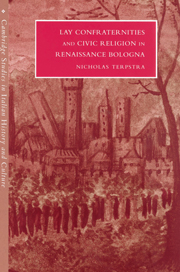Book contents
- Frontmatter
- Contents
- List of figures
- List of tables
- Acknowledgments
- Preface
- Prologue
- 1 The early quattrocento: confraternities, observance movements, and the civic cult
- 2 Lay spirituality and confraternal worship
- 3 The mechanics of membership
- 4 Communal identity, administration, and finances
- 5 Confraternal charity and the civic cult in the late fifteenth and early sixteenth centuries
- Epilogue
- Bibliography
- Index
5 - Confraternal charity and the civic cult in the late fifteenth and early sixteenth centuries
Published online by Cambridge University Press: 24 September 2009
- Frontmatter
- Contents
- List of figures
- List of tables
- Acknowledgments
- Preface
- Prologue
- 1 The early quattrocento: confraternities, observance movements, and the civic cult
- 2 Lay spirituality and confraternal worship
- 3 The mechanics of membership
- 4 Communal identity, administration, and finances
- 5 Confraternal charity and the civic cult in the late fifteenth and early sixteenth centuries
- Epilogue
- Bibliography
- Index
Summary
We have seen that the Observant devotional reforms which created smaller, more closely knit confraternities devoted to penitential flagellation were broadly popular in the fifteenth century. They led to many new groups and the reform, through Stretta sub-groups, of many older ones. Though originating among patrician groups, it was a reform which was embraced eagerly by successive generations of artisanal confratelli, helped in part by the fact that it carried with it the rhetoric of spiritual equality. In practice, as women and later artisanal men found out, the rhetoric itself recast the notion of spiritual community. More intense Observant devotion was articulated in terms of male exclusivity and obedience to spiritual and temporal authorities. As it separated the vita activa from the vita contemplativa, it drove a wedge between a confraternity's inner devotional life and community, and its public charitable activity and cultic responsibilities. Administrations were initially democratized, but under the press of increasing charitable and devotional responsibilities they became more authoritarian; while Trecento authoritarianism had been necessary to hold together a loose community of lay brothers and sisters, its Cinquecento counterpart controlled a more strictly supervised brotherhood. Multiple memberships and human weakness always moderated the dichotomy in practice, but the stage was set for a change in confraternities' social role.
- Type
- Chapter
- Information
- Lay Confraternities and Civic Religion in Renaissance Bologna , pp. 171 - 216Publisher: Cambridge University PressPrint publication year: 1995



